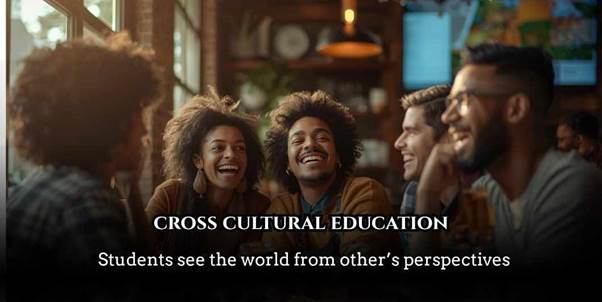In an increasingly interconnected world, cross cultural education has become essential for preparing individuals to thrive in diverse environments. It encourages learners to explore and appreciate different traditions, values, and ways of thinking, fostering empathy and cooperation among people from various backgrounds. This form of education goes beyond textbooks it nurtures global awareness, cultural sensitivity, and open mindedness.
Table of Contents
In this article, we’ll discuss how embracing global learning, promoting multicultural awareness, and strengthening intercultural communication can transform classrooms into inclusive spaces that celebrate diversity. By understanding and respecting cultural differences, education becomes a powerful tool for unity and global progress.

Understanding Cross Cultural Education
Cross cultural education refers to the process of learning that integrates knowledge, values, and practices from various cultures. It aims to help students understand cultural diversity and develop the ability to interact respectfully and effectively with people from different backgrounds. This educational approach goes beyond language or geography it’s about empathy, inclusion, and shared understanding.
By studying diverse traditions, beliefs, and perspectives, learners gain a broader worldview. In today’s globalized world, this skill is essential for personal growth, career success, and peaceful coexistence.
The Historical Background of Cross Cultural Learning
The roots of cross cultural education can be traced back to ancient civilizations where trade and migration encouraged knowledge exchange. However, it gained formal importance during the 20th century with the rise of international relations and global communication. Educational institutions began integrating cultural studies and foreign exchange programs to promote global awareness.
In recent decades, technological advancements and increased migration have accelerated the need for culturally aware education. Schools, universities, and workplaces now prioritize global learning as a means to bridge cultural divides and encourage cooperation among diverse communities.
The Importance of Global and Multicultural Learning
Cross cultural education plays a central role in shaping responsible global citizens. It promotes understanding, tolerance, and appreciation of cultural differences while discouraging prejudice and discrimination.
Key reasons why it matters:
- Encourages empathy: Students learn to see the world from other’s perspectives.
- Promotes inclusivity: Creates a sense of belonging for people from all backgrounds.
- Improves communication: Helps individuals adapt to multicultural environments.
- Enhances problem solving: Exposure to diverse viewpoints leads to innovative thinking.
- Prepares for global careers: Employers value professionals who can work across cultures.
This type of learning helps societies move beyond stereotypes, fostering collaboration and peace through education.
Major Benefits of Cross Cultural Education
Implementing cross cultural education provides both personal and societal benefits.
Personal benefits
- Broader worldview: Students become more aware of how culture shapes identity and values.
- Cultural adaptability: The ability to adjust to new environments and traditions becomes stronger.
- Stronger social skills: Interacting with peers from diverse backgrounds enhances teamwork.
- Emotional intelligence: Understanding others’ feelings and experiences leads to empathy.
Societal benefits
- Community harmony: Cultural understanding reduces social tension and conflict.
- Workplace diversity: Organizations benefit from innovative ideas and perspectives.
- Global unity: Encourages mutual respect and shared responsibility across nations.
Through such learning, individuals become ambassadors of peace and cooperation, leading to stronger global communities.
Challenges in Implementing Cross Cultural Education
Despite its many benefits, promoting this kind of education comes with challenges.
Common obstacles
- Cultural bias: Preconceived stereotypes can hinder mutual understanding.
- Language barriers: Miscommunication often arises in diverse learning environments.
- Limited resources: Schools may lack the materials or training to deliver effective programs.
- Resistance to change: Some communities may be hesitant to embrace cultural diversity.
How to overcome them
- Encourage open dialogue and cultural exchange activities.
- Train teachers to be culturally sensitive and inclusive.
- Integrate cultural content into everyday lessons.
- Use technology and virtual exchange programs to connect students globally.
Addressing these challenges ensures that education remains inclusive and effective in shaping global citizens.
Examples of Cross Cultural Learning in Action
Several successful initiatives around the world demonstrate the positive impact of cross cultural education.
School based programs
- International exchange programs: Students study abroad to experience new cultures firsthand.
- Multicultural festivals: Schools celebrate global traditions, music, and food to promote diversity.
- Collaborative projects: Virtual classrooms allow students from different countries to work together online.
Workplace initiatives
- Diversity training: Companies teach employees how to communicate effectively across cultures.
- Global teamwork: Remote teams from different regions collaborate to solve shared challenges.
- Inclusive leadership: Managers are trained to respect cultural values and encourage participation.
These examples highlight how education and professional development can work hand in hand to promote understanding and cooperation.
The Role of Technology in Cultural Exchange
Modern technology has transformed how cross cultural learning takes place. Online platforms, social media, and digital classrooms connect people across continents instantly.
Technology’s contributions:
- Virtual exchange programs build friendships beyond borders.
- Online resources introduce students to global perspectives.
- Language learning apps promote communication and cultural appreciation.
- Video conferencing enables international collaboration for students and professionals alike.
Through technology, cross cultural education becomes more accessible, engaging, and impactful for learners worldwide.
Building a Culturally Inclusive Future
The future of education lies in embracing cultural diversity. Teachers, parents, and policymakers must work together to create environments where every learner feels valued and understood.
To achieve this, institutions should:
- Integrate global awareness into all subjects.
- Encourage student participation in multicultural events.
- Foster empathy and respect through interactive learning.
By prioritizing these values, cross cultural education will continue to shape a generation of thoughtful, respectful, and globally minded citizens ready to make the world a more connected and compassionate place.

Conclusion
In conclusion, cross cultural education serves as a powerful tool for promoting understanding, respect, and cooperation in today’s diverse world. It encourages learners to appreciate different perspectives, adapt to multicultural environments, and build meaningful global connections. By embracing this educational approach, we can create inclusive communities that value empathy and shared learning. As the world becomes more interconnected, investing in cross cultural education and intercultural communication skills is essential for a peaceful and united future. Explore more about global learning to expand your cultural horizons and understanding.